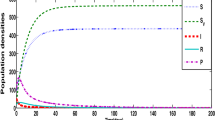Abstract
In this paper, we study a multiple infected compartments model for waterborne diseases which is derived from the continuous case by using the well-known Mickensnon-standard discretization. The positivity of solutions with positive initial conditions and the expressions of equilibria are obtained. By applying analytic techniques and constructing discrete Lyapunov functions, we obtain the results that if \(R_0\le 1\), the disease-free equilibrium is globally asymptotically stable, and if \(R_0>1\) the unique endemic equilibrium is also globally asymptotically stable when the system degenerates the fast-slow system. Furthermore, numerical simulations verify our theoretical results. Our numerical results imply that the decay rate of pathogen in the water has no influence on endemic equilibrium, but it has a significant impact on the peak value of infected individuals.


Similar content being viewed by others
References
WHO. Cholera: global surveillance summary. Wkly. Epidemiol. Rec. 2008 84 309-324 (2009)
Liu, L., et al.: Global, regional, and national causes of child mortality: an updated systematic analysis for 2010 with time trends since 2000. Lancet 379, 2151–2161 (2012)
Goh, K., Teo, S., Lam, S., Ling, M.: Person-to-person transmission of cholera in a psychiatric hospital. J. Infect. 20, 193–200 (1990)
Hartley, D., Morris, J., Smith, D.: A critical element in the ability of V. cholerae to cause epidemics. PLOS Med. 3, 63–69 (2006)
Koelle, K., Pascual, M., Yunus, M.: Pathogen adaptation to seasonal forcing and climate change. Proc. R. Soc. Lond. B 272, 971–977 (2005)
Li, M., Ma, J., van den Driessche, P.: Model for disease dynamics of a waterborne pathogen on a random network. J. Math. Biol. 201, 389–394 (2014)
Miller, J.C.: SIR dynamics in random networks. J. Math. Biol. 62, 349–358 (2011)
Tien, J.H., Earn, D.J.D.: Multiple transmission pathways and disease dynamics in a waterborne pathogen model. Bull. Math. Biol. 72, 1506–33 (2010)
Wang, Y., Cao, J.: Global stability of a multiple infected compartments model for waterborne diseases. Commun. Nonlinear Sci. Numer. Simul. 19, 3753–3765 (2014)
Berman, A., Plemmons, R.J.: Nonnegative Matrices in the Mathematical Sciences. Academic Press, New York (1994)
Hu, Z., Teng, Z., Zhang, L.: Stability and bifurcation analysis in a discrete SIR epidemic model. Math. Comput. Simul. 97, 80–93 (2014)
Li, X., Wang, W.: A discrete epidemic model with stage structure. Math. Chaos Solitons Fractals 26, 947–958 (2005)
Mickens, R.E.: Nonstandard Finite Difference Model of Differential Equations. World Scientific, Singapore (1994)
Mickens, R.E.: Application of Nonstandard Finite Difference Schemes. World Scientific, Singapore (2000)
Mickens, R.E.: Nonstandard finite difference schemes for differential equations. J. Differ. Equ. Appl. 8, 823–847 (2002)
Anguelov, R., Lubuma, J.M.S.: Contributions to the mathematics of the nonstandard finite difference method and applications. Numer. Methods Partial. Differ. Equ. 17, 518–543 (2001)
Anguelov, R., Lubuma, J.M.S.: Nonstandard finite difference method by nonlocal approximation. Math. Comput. Simul. 61, 465–475 (2003)
Segel, L.: On the validity of the steady state assumption of enzyme kinetics. Bull. Math. Biol. 50, 579–93 (1988)
Ding, D., Ma, Q., Ding, X.: A non-standard finite difference scheme for an epidemic model with vaccination. J. Differ. Equ. Appl. 19, 179–190 (2013)
Masaki, S., Emiko, I.: Global dynamics of a discretized SIRS epidemic model with time delay. J. Math. Anal. Appl. 371, 195–202 (2010)
Masaki, S.: Permanence of a discrete SIRS epidemic model with time delays. Appl. Math. Lett. 23, 1280–1285 (2010)
Wang, W.: Global behavior of an SEIRS epidemic model with time delays. Appl. Math. Lett. 15, 423–428 (2002)
Hu, Z., Teng, Z., Jia, C., Zhang, L., Chen, X.: Complex dynamical behaviors in a discrete eco-epidemiological model with disease in prey. Adv. Differ. Equ. 2014, 265 (2014)
Van den Driessche, P., Watmough, J.: Reproductive numbers and subthreshold endemic equilibria for compartmental models of disease transmission. Math. Biosci. 180, 29–48 (2002)
Han, D., Sun, M., Li, D.: Epidemic process on activity-driven modular networks. Phys. A 432, 354–362 (2015)
Han, D., Sun, M.: Can memory and conformism resolve the vaccination dilemma? Phys. A 415, 95–104 (2014)
Han, D., Sun, M., Li, D.: The virus variation model by considering the degree-dependent spreading rate. Phys. A 433, 42–50 (2015)
Enatsu, Y., Nakata, Y., Muroya, Y.: Global stability for a class of discrete SIR epidemic models. Math. Biosci. 7, 347–361 (2010)
Acknowledgments
The research has been supported by the Natural Science Foundation of China (11261004, 11561004), the Natural Science Foundation of Jiangxi Province (20151BAB201016), and the Postgraduate Innovation Fund of Jiangxi Province (YC2014-S410).
Author information
Authors and Affiliations
Corresponding author
Rights and permissions
About this article
Cite this article
Zhang, L., Gao, S. & Zou, Q. A Non-Standard Finite Difference Scheme of a Multiple Infected Compartments Model for Waterborne Disease. Differ Equ Dyn Syst 28, 59–73 (2020). https://doi.org/10.1007/s12591-016-0296-8
Published:
Issue Date:
DOI: https://doi.org/10.1007/s12591-016-0296-8




